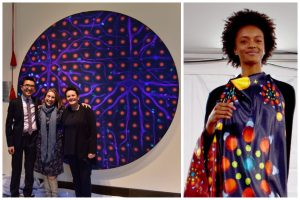
When Mingyu Yang ’19 went to MIT to pursue his PhD in Health Sciences & Technology, he expected long hours in the lab, using his degree in materials science and engineering and neuroscience to develop better models of myelination, the process by which the body forms a fatty tissue that insulates parts of brain cells.
What he did not anticipate was that some of his work would not only end up hanging in an art exhibition, but also inspiring clothing worn by models strutting on the catwalks of Boston’s Fashion Week 2022.
While Yang was trying to grow cells called oligodendrocytes so that they could produce myelin around his 3-D-printed axons, he found he was instead producing astrocytes, cells that hold nerves in place and help them develop. They are important, but they don’t produce myelin.
Frustrated, he broke out the microscope to see exactly what the astrocytes looked like.
“When I put the astrocytes under fluorescent microscope, I said ‘Wow, there are actually tons of astrocytes, and they actually have this kind of beautiful morphology.’ They are starlike. My mentality was well, if you can’t quite make science with them, let’s try making art,” he says.
At the time, the Koch Institute Public Galleries in Cambridge were displaying “science art,” so Yang submitted his picture with the title “Astrocyte Highways: The Secret Garden of the Central Nervous System.” He was astonished when it was accepted.
“I came to visit MIT when I was a junior at Hopkins and didn’t think I would get in, let alone have my research displayed in the gallery that I walked past as a college student. That’s wild to me. That was the cusp of how cool it could get,” he says.
It got even cooler though when the Cambridge Science Festival, a 10-day event held by MIT, Harvard, and the City of Cambridge celebrating “the leading edge in science, technology, engineering, art, and math,” informed him that designers had created clothing inspired by his image that would be part of Boston’s Fashion Week.
Yang was front and center for the show in the heart of Cambridge’s Kendall Square.
“I got to meet the artists and they were excited to meet the scientist that took the picture! I think I was way more starstruck to meet them, though. I mean, how did this one little image end up as an inspiration for a runway outfit at the Boston Fashion Week fashion show? I enjoy talking about science in unconventional spaces and I will probably never get the chance again to talk about science at a fashion show,” he says.
Indeed, talking about and explaining science and its myriad applications is a skill of Yang’s, who also makes food science videos on topics ranging from phase transitions in cooking chicken to the crystal structures of chocolate.
“It’s really nice to have some secondary outlet. Lab work is in some ways an interminable journey and it can sometimes feel like an endless slog. In my research, some experiments can go for upwards of 90 days and it’s hard to see the incremental growth in that,” he says.
Yang says his enjoyment in finding creative ways to educate people about how materials science plays important roles in their everyday lives exemplifies his love of teaching. In fact, his goal is a job where the focus is on teaching and mentorship.
Many of his favorite academic experiences involve working students who “who have never pipetted before, and never cared for cells before, and I get to show them what the practice of science is like.” He says that this is because he understands the importance of the undergraduate college experience, as well as its pitfalls.
A native of Hong Kong, Yang arrived on the Hopkins campus knowing no one and having very little knowledge about the American college system. Things that came easily to many others, like the credit system, choosing classes, and semester schedules, were new concepts to him.
As a result, during his time at Hopkins, Yang explored the best approaches to helping first-year students adjust to and feel included in the university STEM community. While working as a TA in Professor Hai-Quan Mao’s biomaterials lab, for instance, he says he helped students learn not only about materials science, but also how to navigate life as a college student.
At MIT, his advisor encouraged his interest in education and helped him create what he calls his proudest accomplishment: designing open-source education material to democratize access to STEM education. Over the first two years there, Yang’s team designed a handful of online classes, including one on manufacturing cell therapy that is offered free on EdX. The course has reached thousands of students already, many of whom may not otherwise have access to this knowledge, he says.
“I’m really grateful for my time at Hopkins, it really sowed the seeds for all of this. I discovered biomaterials through Dr. Mao’s class. I had no idea what aspect of material science I was interested in coming into college and now I work in a lab that studies biomaterials. Literally everything that has happened that is cool I can trace back to the seeds being sown at Hopkins,” he says.